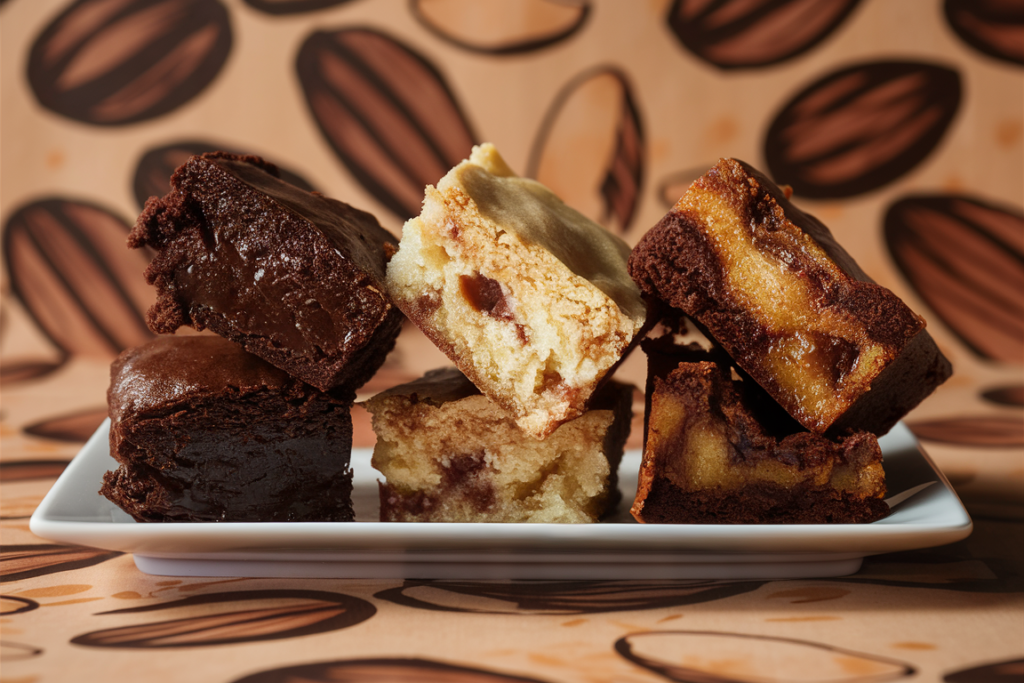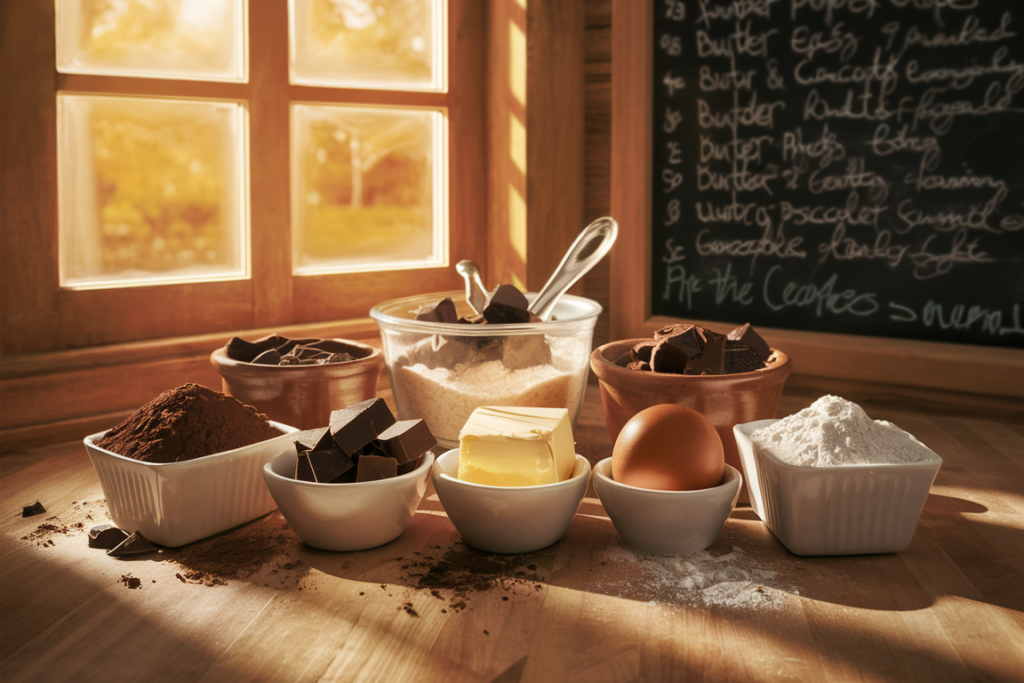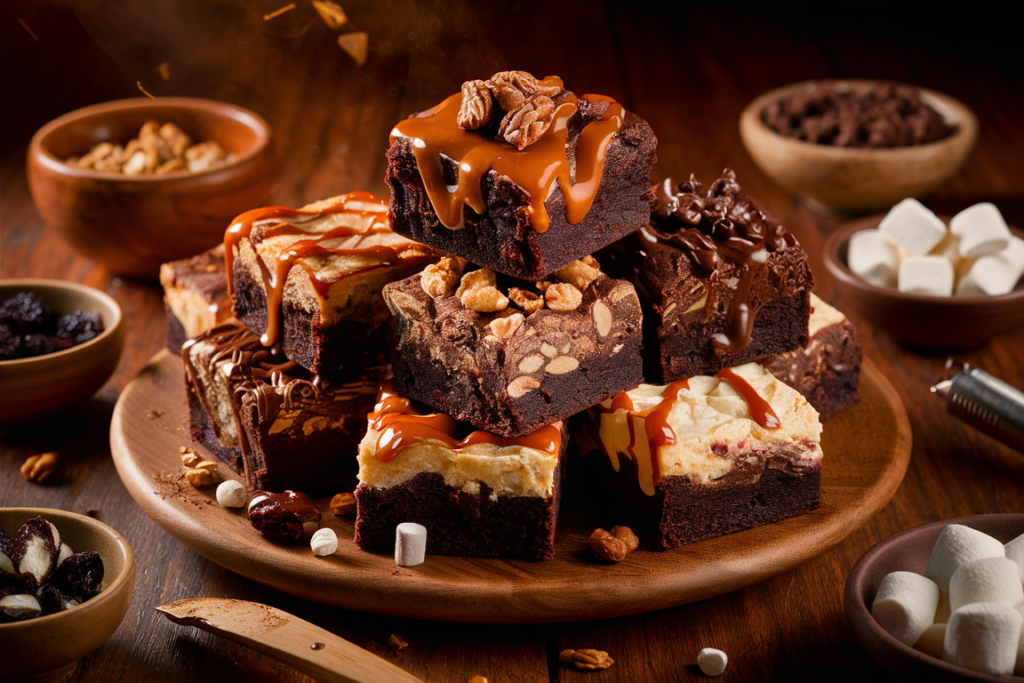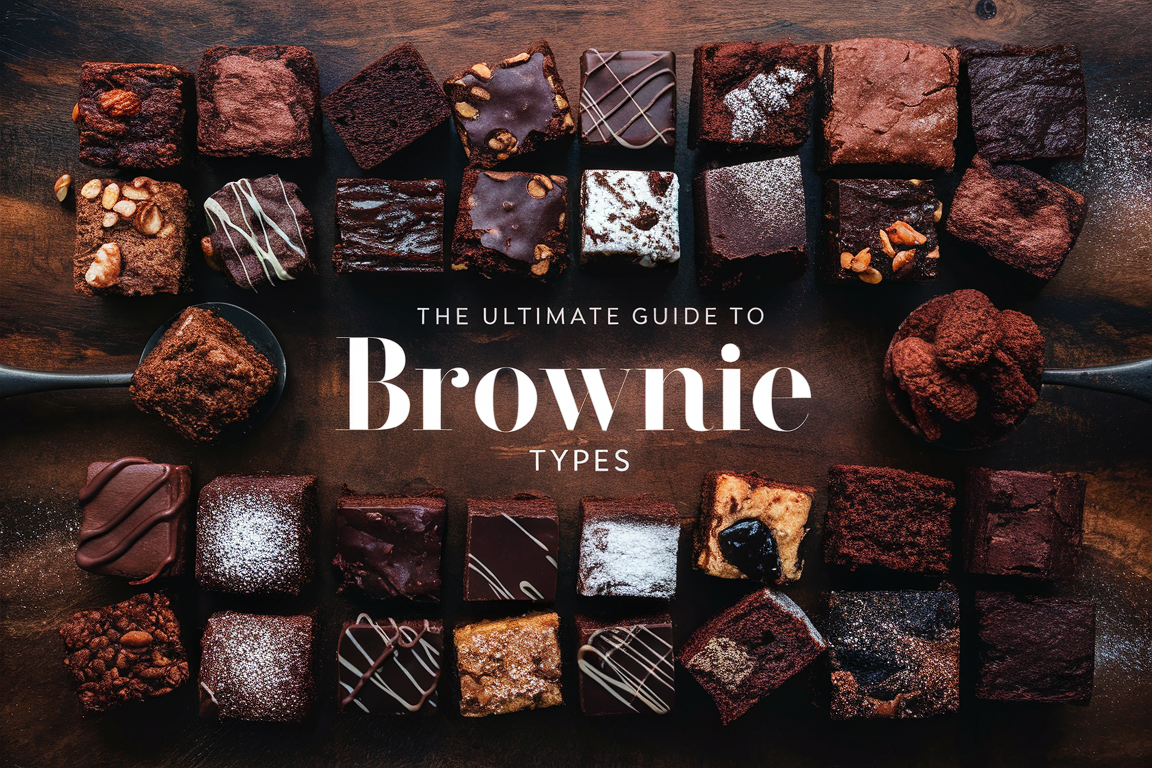The Three Types of Brownies
Part 1: Introduction and Overview
Introduction to Brownies
Brownies are one of the most beloved desserts worldwide, capturing hearts with their rich chocolate flavor and versatile texture. Whether you prefer them chewy, fudgy, or cakey, brownies cater to a variety of taste preferences, making them a dessert staple. But what exactly defines a brownie, and why do they hold such universal appeal?
What Defines a Brownie?
A brownie is more than just a square of chocolatey goodness. Its defining features are:
- A chocolate-based dessert with a dense texture.
- A balance between sweetness and richness, often paired with subtle bitter notes from cocoa.
- Variations in texture, ranging from soft and gooey to light and airy.
Truly, the beauty of brownies lies in their simplicity. With just a few common ingredients—flour, sugar, butter, eggs, and cocoa powder—they can easily transform into a dessert with near-endless possibilities. Furthermore, their straightforward recipe allows for countless variations, making them adaptable to nearly any occasion.
A Brief History of Brownies
Origin and Evolution
The origins of brownies are surprisingly American, with the first recorded recipe dating back to the late 19th century. According to historical accounts, the first brownies were more like a cross between cake and cookie, differing significantly from modern variations. Over time, the recipe evolved, introducing ingredients like chocolate and adjusting proportions to create the diverse textures we know today.
Why Brownies Are a Global Favorite
Over time, brownies have traveled far from their American roots to become a global phenomenon. One of the key reasons behind their popularity is their versatility. Additionally, they are incredibly easy to prepare, making them accessible to bakers of all skill levels. Moreover, the universal appeal of chocolate has helped brownies transcend cultural boundaries, ensuring their place as a beloved dessert worldwide.
- Versatility: From classic recipes to gluten-free and vegan adaptations, brownies are endlessly customizable.
- Ease of Preparation: A simple recipe that even novice bakers can master.
- Universality of Chocolate: Chocolate’s allure knows no cultural boundaries, and brownies make it shine.
Exploring the Diversity of Brownie Types
Characteristics of Each Type
When it comes to brownies, texture is king. There are three primary types:
- Fudgy Brownies: Dense, moist, and almost truffle-like.
- Cakey Brownies: Light, airy, and similar to chocolate cake.
- Chewy Brownies: A delightful middle ground, offering a firm bite and satisfying chew.
Key Ingredients That Set Brownies Apart
While the foundational ingredients are similar, slight adjustments create major differences in texture:
- Butter vs. Oil: Butter adds richness, while oil creates a softer crumb.
- Egg Quantity: More eggs yield a cakier texture.
- Chocolate Ratio: Higher chocolate content produces fudgier results.
- Sugar Type: Brown sugar enhances chewiness, while white sugar lightens the structure.
The Role of Texture and Flavor in Brownie Types
Chewy, Fudgy, and Cakey – What Do They Mean?
Understanding the differences between these textures is essential to identifying your favorite brownie type:
- Fudgy: Offers a dense, rich experience with minimal crumb.
- Cakey: Feels light and airy, with a more pronounced crumb structure.
- Chewy: Strikes a balance with a firm yet elastic texture.
Each type has its own loyal fanbase, and every bite offers a distinct culinary experience.
The Three Types of Brownies

Part 2: The Three Main Types of Brownies
Understanding the Three Main Types of Brownies
Brownies are loved for their diverse textures and flavors. Whether you’re a fan of rich, gooey decadence or a light, airy bite, there’s a brownie type to suit every preference. The three main types—fudgy, cakey, and chewy—are defined by their unique ingredients, preparation methods, and baking techniques. Let’s explore each in detail.
1. Fudgy Brownies
Defining Fudgy Texture
Fudgy brownies are the ultimate indulgence. They’re characterized by their:
- Dense, moist interior that melts in your mouth.
- Slightly underbaked center for a gooey finish.
- Glossy, crackly top achieved through the perfect sugar-egg emulsion.
Fudgy brownies often resemble chocolate truffles in texture, offering a rich and intense chocolate flavor.
Common Ingredients for Fudgy Brownies

The secret to fudgy brownies lies in the ingredient proportions:
- High fat-to-flour ratio: More butter or chocolate and less flour.
- Eggs: Typically fewer eggs to avoid excess lift.
- Sugar: A balance of granulated and brown sugar adds richness and stability.
Using melted chocolate instead of just cocoa powder deepens the flavor and enhances the moistness.
Popular Recipes for Fudgy Brownies
Many iconic recipes focus on creating fudgy perfection. A few tricks include:
- Using high-quality dark chocolate for depth of flavor.
- Adding a tablespoon of coffee to intensify the chocolate profile.
- Baking at a slightly lower temperature to retain moisture.
2. Cakey Brownies
What Makes a Brownie Cakey?
Cakey brownies are for those who enjoy a lighter, fluffier dessert. They are:
- Airy and tender, with a crumbly structure.
- Less rich than fudgy brownies but still full of chocolate flavor.
- Similar in texture to a moist chocolate cake, but denser.
Cakey brownies are perfect for layering with frosting or pairing with a dollop of whipped cream.
Differences Between Cake and Cakey Brownies
While both have a light structure, cakey brownies differ in several ways:
- Density: Brownies are denser than cakes due to less leavening.
- Fat Content: Brownies use less fat, focusing on chocolate for richness.
- Size: Brownies are typically cut into squares, while cakes are served in slices.
Variations in Recipes for Cakey Brownies
To achieve a cakier texture:
- Increase the amount of eggs, as they provide structure and lift.
- Use more flour to create a firmer base.
- Whisk the batter longer to incorporate air.
For an easy, fluffy treat, try this cakey brownie recipe that guarantees perfect results every time.
3. Chewy Brownies
The Secret to a Chewy Texture
Chewy brownies are the perfect middle ground between fudgy and cakey. They are:
- Firm but pliable, with a texture that offers resistance when bitten.
- Moist without being gooey, thanks to the right balance of ingredients.
- Perfect for those who love texture in every bite.
Ingredients That Add Chewiness
The key ingredients for chewy brownies include:
- Brown sugar: Its molasses content adds moisture and chew.
- Egg yolks: Provide richness and structure.
- Gluten development: Slightly more mixing helps develop chewiness.
Chewy brownies often have a distinct, caramelized flavor due to the use of brown sugar.
Best Techniques for Chewy Brownies
To achieve the ultimate chewy texture:
- Use a mix of melted butter and oil for the perfect balance of richness and elasticity.
- Chill the batter before baking to allow flavors to develop and create a denser texture.
- Bake at a moderate temperature to prevent over-drying.
For a classic recipe, check out this guide to chewy brownies.
Key Takeaways
Each type of brownie offers a unique experience:
- Fudgy brownies are rich and indulgent.
- Cakey brownies provide a light, chocolatey delight.
- Chewy brownies strike a balance with their firm texture and caramel notes.
By understanding the ingredients and techniques behind these types, you can fully customize brownies to your liking. As a result, this knowledge ensures that every batch is perfectly tailored to satisfy your cravings. In this way, you can create desserts that align with your personal preferences and baking goals.
The Three Types of Brownies
Part 3: Customizations and Comparisons
Customizing Brownies to Suit Your Preference
Brownies are one of the most versatile desserts, offering endless possibilities for customization. By adjusting ingredients, baking times, and add-ins, you can tailor your brownies to meet any craving—whether it’s for something decadently rich or light and airy.
Balancing Texture and Flavor
Adjusting Baking Time for Different Textures
- For Fudgy Brownies: Reduce the baking time slightly and remove the brownies from the oven when the center is just set. The residual heat will continue to cook them, keeping the texture dense and moist.
- For Cakey Brownies: Bake for the full recommended time, ensuring the batter is fully set and airy.
- For Chewy Brownies: A moderate baking time is key. Test with a toothpick—there should be moist crumbs, but not raw batter.
Role of Add-ins: Nuts, Chocolate Chips, and More
Adding mix-ins enhances the flavor and texture of brownies. Popular choices include:
- Nuts (walnuts, pecans, hazelnuts): Add crunch and balance the sweetness.
- Chocolate Chips or Chunks: Intensify the chocolate flavor and create melty pockets.
- Caramel or Peanut Butter Swirls: Introduce contrasting textures and flavors.
- Fruits (dried cherries, raspberries): Offer tartness that complements rich chocolate.
For instance, you can try incorporating marshmallows, pretzels, or even a swirl of cream cheese for extra indulgence. Additionally, these unique ideas add exciting textures and flavors, making your brownies truly stand out. As a result, your creations will offer a delightful twist on the classic recipe.
Comparing the Three Brownie Types
Textural Differences
- Fudgy: Dense and moist, with minimal crumb.
- Cakey: Light, airy, and more structured.
- Chewy: Firm but pliable, offering resistance when bitten.
Flavor Profiles
- Fudgy Brownies: Rich and intense, often likened to a chocolate truffle.
- Cakey Brownies: Sweet and chocolatey, but less overwhelming.
- Chewy Brownies: A balanced chocolate flavor with subtle caramel undertones.
Ideal Occasions for Each Type
- Fudgy Brownies: Best for special occasions or when serving with ice cream.
- Cakey Brownies: Perfect for casual gatherings or as a tea-time treat.
- Chewy Brownies: Great for snacking or packing in lunchboxes due to their satisfying texture.
Advanced Variations Beyond the Basics
Gluten-Free and Vegan Brownies
- Gluten-Free: Substitute all-purpose flour with almond flour or a gluten-free blend. Ensure any chocolate used is certified gluten-free.
- Vegan: Replace eggs with flaxseed meal or applesauce and use plant-based butter or coconut oil. Opt for vegan chocolate for authenticity.
Gourmet Additions: Salted Caramel, Espresso, and More
Elevate your brownies with gourmet ingredients:
- Salted Caramel: Drizzle caramel over the batter before baking for a sweet-salty contrast.
- Espresso Powder: Intensifies chocolate flavor and adds a subtle coffee note.
- Spices (cinnamon, chili powder): Add warmth and a touch of heat.
- Alcohol (bourbon, Kahlúa): Introduce complexity and depth to the batter.
These additions create brownies that feel indulgent and sophisticated.
Conclusion: Celebrating the Versatility of Brownies
Choosing the Perfect Brownie Type for You
The ideal brownie depends on your preferences:
- Love rich, chocolatey desserts? Go for fudgy brownies.
- Prefer light, airy treats? Cakey brownies are your match.
- Want something satisfying and chewy? Opt for chewy brownies.
Experiment with different ingredients, techniques, and add-ins to discover your ultimate favorite.
Experimenting to Create Your Signature Recipe
Don’t be afraid to experiment and break the rules. For example, you can combine techniques—such as using the butter-to-flour ratio of fudgy brownies with the sugar content of chewy brownies—to craft your unique signature dessert. Moreover, this approach allows you to create a treat that perfectly aligns with your personal taste. In the end, the possibilities are endless when you think outside the box. Brownies offer endless opportunities for creativity, so let your imagination guide your baking journey.
More FAQs About Brownies
- What’s the best way to store brownies?
- Keep them in an airtight container at room temperature for 3–4 days. For longer storage, freeze them.
- Why do my brownies crack on top?
- A crackly top forms when sugar and eggs are beaten well, creating a meringue-like crust.
- Can I use cocoa powder instead of melted chocolate?
- Yes, but the texture and flavor will differ. Cocoa powder makes brownies denser, while melted chocolate adds moisture.
- How do I make brownies gooier?
- Use less flour and a shorter baking time. Avoid overmixing the batter.
- Can I add alcohol to brownie batter?
- Absolutely! Add a tablespoon of bourbon, rum, or liqueur for a boozy twist.
- What’s the difference between blondies and brownies?
- Blondies use vanilla and brown sugar instead of chocolate, creating a butterscotch flavor.
- How do I prevent brownies from sticking to the pan?
- Line the pan with parchment paper and grease it lightly.
- What type of chocolate is best for brownies?
- High-quality dark chocolate (60–70% cocoa) provides the best flavor.
- Why are my brownies too dry?
- Overbaking is the most common cause. Ensure you check them frequently as they bake.
- Can I double a brownie recipe?
- Yes, but use a larger pan and adjust the baking time accordingly.
With this deep dive into the three types of brownies, their customizations, and advanced variations, you’re ready to bake the perfect batch tailored to your taste. Happy baking! 🍫


